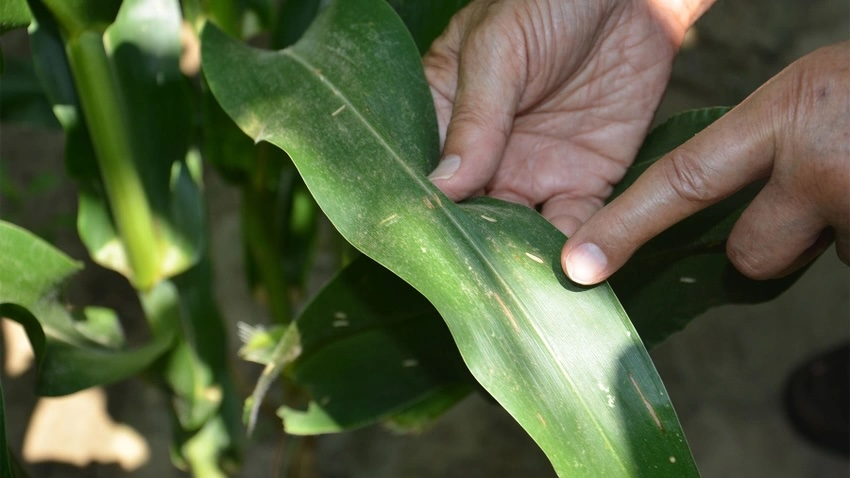Get ready for disease scouting now

When should I start scouting for disease? Which diseases should I look for? What are the symptoms? How do I know there are enough lesions to order fungicide?
The Indiana certified crop advisers panel answering this question includes Gene Flaningam, crops consultant, Vincennes; Carl Joern, field agronomist with Pioneer, northeast Indiana; Greg Kneubuhler, agronomist, G&K Concepts Inc., Harlan; and Dan Quinn, Purdue Extension corn specialist, West Lafayette.
Flaningam: Scouting for disease in corn to determine thresholds is not an exact science, but more of an art. Disease development takes optimal temperature, humidity and source. On continuous corn acres, start scouting pretassel to determine how hybrids are performing, and when to apply a fungicide. If corn has a disease in the midcanopy by pretassel, consider that field is a candidate for fungicide.
With corn at tassel stage, it’s critical to keep disease below the ear leaf. Late-planted corn may have to be sprayed twice with a fungicide, depending on disease pressure. Late-planted corn produces grain at peak disease development periods. So, it will often take a higher level of management.
Keep an eye on the forecast for favorable disease conditions. Continue scouting to make that fungicide pass profitable. Use the Purdue Corn and Soybean Field Guide to help identify the exact disease in your field.
Joern: Start scouting for foliar corn disease by Independence Day. For a disease to proliferate, it must have a conducive environment. The heat and humidity necessary for gray leaf spot, northern corn leaf blight and tar spot do not establish until the beginning of summer. On irrigated fields, begin scouting sooner.
How does one know when to order a fungicide? It could take the balance of this publication to answer! In brief, let your scouting and budget inform spray decisions. Prioritize fields with hybrids that may have a lower tolerance to certain diseases, fields of continuous corn, those with reduced tillage and those with higher revenue potential.
Look toward the bottom of the canopy to catch an early infection. It’s a red flag if you notice lesions at or just below the ear leaf. It is imperative to keep the ear leaf and leaves above it clean throughout grain fill.
Tar spot looks like flecks of tar splattered onto the leaf. They cannot be rubbed off like insect frass. Gray leaf spot starts as small, rectangular lesions, largely contained within leaf veins. This can be confused with “windowpane” feeding by insects with chewing mouth parts. Northern corn leaf blight is characterized by cigar-shaped lesions.
Fungicides do not add bushels but protect yield potential. Remember that most fungicides provide a couple to three weeks of protection. The most important three weeks of protection are up to each grower.
In my experience, more acres are sprayed too early rather than too late. More growers who I work with wish they had applied a fungicide, rather than regretting that expense later. Again, be mindful of what you find in your scouting. If there is no disease, there is less likely to be a return. If you wait until disease has largely consumed the plant, your window to apply a has fungicide passed. It may still have a positive impact on standability, but I would doubt maximum yield benefit could still be attained.
In broad strokes, the window of late R1, silking, to R3, milk or roasting ear, seems to be the sweet spot most years.
The world of disease modeling and progression continues to advance. Keep your ear to the ground for opportunities to partner with providers that can help predict disease onset and prioritize fields to be applied with fungicide.
Kneubuhler: For a disease to start in corn, you need to fulfill the disease triangle: environment, pathogen and host plant. Most of the time, these conditions don’t mesh well until V10 or beyond. Each corn disease has its own symptoms. Know symptoms for tar spot, northern corn leaf blight, gray leaf spot and, if you live in southern Indiana, southern rust.
Our experience and data show that fungicide applications are much more effective when done before disease shows up. Once inoculum gets a foothold, it’s difficult to lessen its effects.
Quinn: Scouting for diseases in corn should start at emergence, specifically when soils are cool and wet. Seedling diseases can cause stunted or missing plants. Then, start scouting two to three weeks before pollination to assess the need for fungicide at tassel. Fungicide applications at R1 to R2 are often most effective for control and yield response.
Assess what diseases are present and where the diseases are present within the plant canopy. If the big three, mentioned earlier, are present in the lower canopy and weather conditions are conducive for disease expansion, these diseases will likely worsen and will warrant a fungicide application. Conditions conducive to disease vary but include high moisture and high humidity. Somewhat cooler conditions favor northern corn leaf blight. Furthermore, if tar spot is present prior to tassel in the lower canopy, even at low levels, this will most likely require a fungicide application. It can spread quickly.
Many times, in dry years and when disease arrives during grain fill and just before plant maturity, you will be less likely to observe a response to fungicide.

